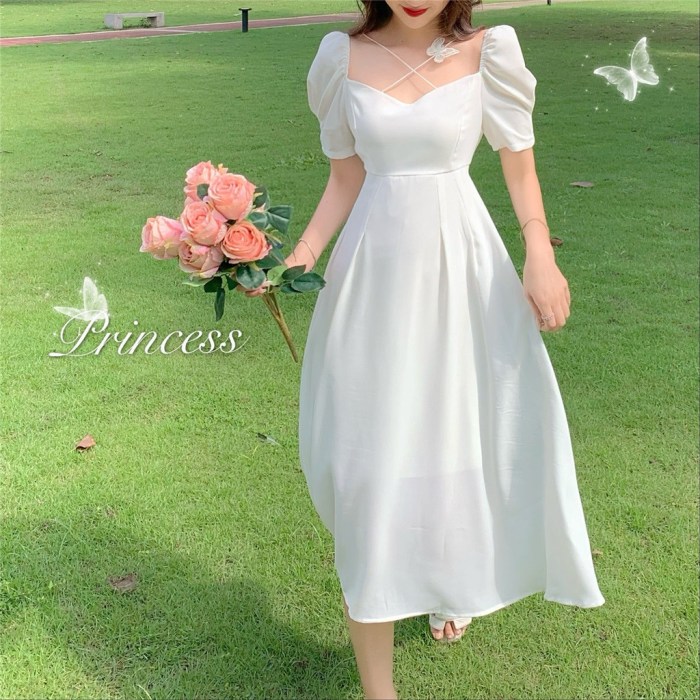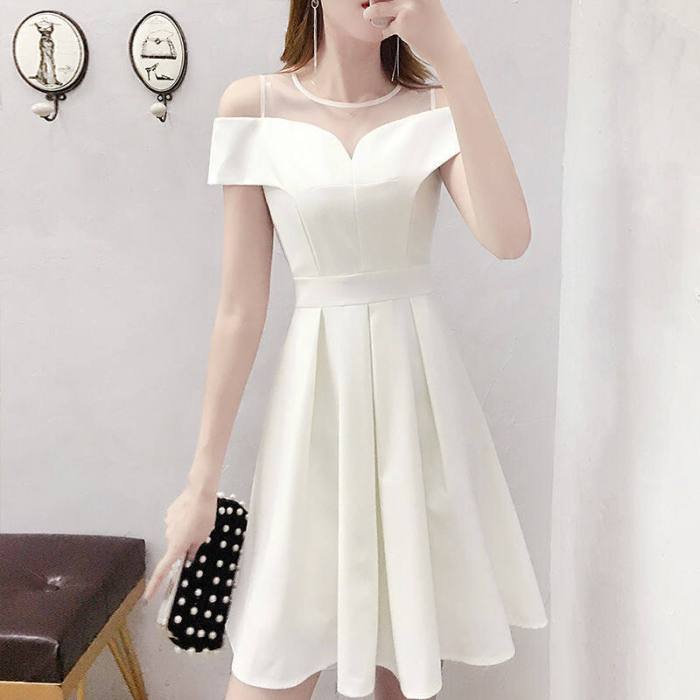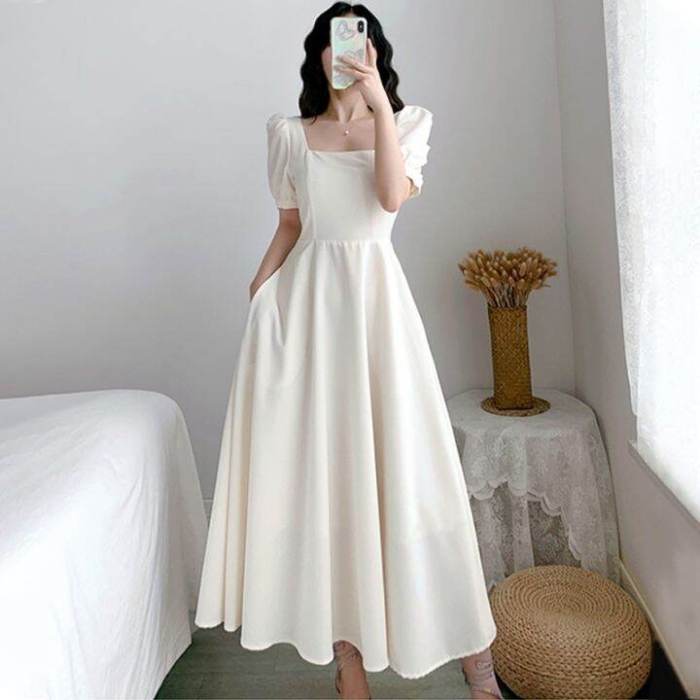A Timeless Elegance: The Evolution and Design of Formal White Wedding Dresses

Source: shopee.ph
Formal white wedding dresses – The formal white wedding dress, a symbol of purity and elegance, has undergone a fascinating evolution throughout history. Its journey reflects societal shifts, technological advancements, and ever-changing aesthetic preferences. This exploration delves into the historical development, design elements, silhouettes, modern trends, and illustrative examples of these iconic garments.
Historical Evolution of Formal White Wedding Dresses
The tradition of wearing white for weddings is surprisingly recent. Before Queen Victoria’s 1840 wedding, brides wore a variety of colors, often reflecting their social standing and available fabrics. Victoria’s choice of a white gown, made of Honiton lace, irrevocably linked white with bridal attire, establishing a standard that continues to this day. This choice, influenced by the burgeoning romantic movement and the association of white with purity and virtue, profoundly impacted wedding fashion.
Subsequent eras saw variations in silhouette, fabric, and embellishment, mirroring broader fashion trends and cultural values.
| Era | Defining Characteristics | Notable Designers (if applicable) | Influencing Factors |
|---|---|---|---|
| Victorian Era (1837-1901) | Full skirts, long trains, high necklines, often featuring lace and embroidery. | Charles Frederick Worth | Romantic ideals, emphasis on modesty and virtue. |
| Edwardian Era (1901-1910) | S-bend silhouette, long sleeves, high necklines, use of delicate fabrics like silk and lace. | Paul Poiret | Emphasis on elegance and refinement. |
| 1920s | Dropped waistlines, shorter hemlines, simpler designs, use of beaded embellishments. | Coco Chanel | The flapper era’s influence on fashion. |
| 1950s | Full skirts, cinched waists, often featuring lace or satin. | Christian Dior | Post-war optimism and a return to traditional femininity. |
| Modern Era (1960s-Present) | Diverse styles, from minimalist sheath dresses to elaborate ballgowns; experimentation with fabrics and silhouettes. | Vera Wang, Carolina Herrera | Individual expression, diverse cultural influences, technological advancements. |
Design Elements and Fabrics

Source: slatic.net
Formal white wedding dresses utilize a range of design elements and fabrics to achieve diverse aesthetic effects. The choice of fabric and embellishments significantly impacts the overall look and feel of the dress, reflecting both the bride’s personal style and the formality of the occasion.
Fabrics such as silk, satin, tulle, and lace each possess unique properties. Silk offers luxurious drape and sheen, satin provides a smooth, glossy finish, tulle provides volume and texture, and lace adds intricate detailing. The choice of fabric often depends on the season (lightweight fabrics for summer, heavier fabrics for winter) and the desired silhouette.
Here are three example dress designs:
- Silk A-Line Gown:
- Fabric: Luxurious silk charmeuse
- Silhouette: Classic A-line, flattering to most body types
- Embellishments: Minimalist approach, with delicate hand-beading along the neckline and waist.
- Aesthetic: Elegant simplicity, emphasizing the quality of the fabric and the clean lines of the silhouette.
- Lace Ballgown:
- Fabric: Chantilly lace over silk lining
- Silhouette: Full ballgown skirt with a fitted bodice
- Embellishments: Intricate lace detailing throughout the gown, with delicate pearl accents.
- Aesthetic: Romantic and traditional, emphasizing intricate detailing and classic elegance.
- Satin Mermaid Gown:
- Fabric: Heavy satin with a subtle sheen
- Silhouette: Form-fitting mermaid silhouette, emphasizing curves
- Embellishments: Clean lines with a dramatic train, possibly featuring a subtle crystal embellishment at the waist.
- Aesthetic: Modern and glamorous, emphasizing a sleek and sophisticated silhouette.
Silhouettes and Styles
The silhouette of a wedding dress plays a crucial role in determining its overall aesthetic and how it flatters the bride’s body type. Popular silhouettes include A-line, ballgown, mermaid, and sheath styles. Each silhouette offers unique advantages and disadvantages, influencing the choice based on factors such as body shape, venue, and personal preference.
| Silhouette | Description | Body Type Suitability | Example Embellishments |
|---|---|---|---|
| A-line | Fitted at the shoulders, gradually widening towards the hem. | Most body types | Lace, embroidery, beading |
| Ballgown | Fitted bodice with a full, voluminous skirt. | Hourglass, pear, and apple shapes | Lace appliqués, beading, ruffles |
| Mermaid | Fitted through the hips and flares out below the knees. | Hourglass and athletic builds | Simple embellishments, focusing on the silhouette |
| Sheath | Straight, close-fitting silhouette. | Slender builds | Delicate beading, subtle embroidery |
Modern Trends and Innovations
Contemporary wedding dress design reflects evolving societal values and technological advancements. Sustainability and ethical production are gaining importance, with designers increasingly using eco-friendly fabrics and ethical manufacturing practices. Social media significantly influences trends, showcasing diverse styles and inspiring new designs.
Technological innovations are also impacting the industry. Examples include:
- 3D printing: Creating intricate and unique designs not possible with traditional methods.
- Laser cutting: Precisely cutting intricate patterns in fabric for embellishments.
- Digital design software: Allowing for detailed visualization and customization of designs.
Illustrative Examples of Formal White Wedding Dresses

Source: slatic.net
Here are three examples of formal white wedding dresses, highlighting their unique design features:
- Dress 1: A flowing A-line gown crafted from ivory silk crepe, featuring delicate Alençon lace appliqués cascading down the skirt. The bodice is adorned with subtle hand-beading, creating a subtle shimmer. The overall aesthetic is one of effortless elegance and understated luxury.
- Dress 2: A classic ballgown in shimmering white satin, with a fitted bodice and a voluminous skirt. The bodice features intricate embroidery in a floral pattern, while the skirt is accented with layers of delicate tulle for added volume. The overall aesthetic is romantic and dramatic.
- Dress 3: A modern sheath dress in crisp white silk, featuring a high neckline and a sleek, minimalist design. The dress is accented with a subtle scattering of Swarovski crystals along the neckline and waistline, adding a touch of sparkle. The overall aesthetic is sophisticated and chic.
FAQ: Formal White Wedding Dresses
What is the average cost of a formal white wedding dress?
The cost varies greatly depending on designer, fabric, embellishments, and retailer. Prices can range from a few hundred dollars to tens of thousands.
How far in advance should I order my wedding dress?
It’s generally recommended to order your dress 6-12 months in advance, especially for custom designs or popular styles.
Formal white wedding dresses often evoke a sense of timeless elegance, a feeling one might wish to extend beyond the ceremony. To create a similarly serene and calming atmosphere at home, consider incorporating elements of nature, such as a stunning künstlicher wasserfall wohnzimmer , which can add a touch of tranquility to your living space. This complements the sophisticated aesthetic of a formal white wedding dress, bringing a similar sense of peace and refinement to your daily life.
How do I find a wedding dress that flatters my body type?
Consult with a bridal stylist who can guide you towards silhouettes that complement your figure. Consider your personal style and the overall aesthetic of your wedding.
What are some eco-friendly options for formal wedding dresses?
Look for dresses made from sustainable fabrics like organic cotton or recycled materials. Consider renting a dress or purchasing a pre-owned gown.
